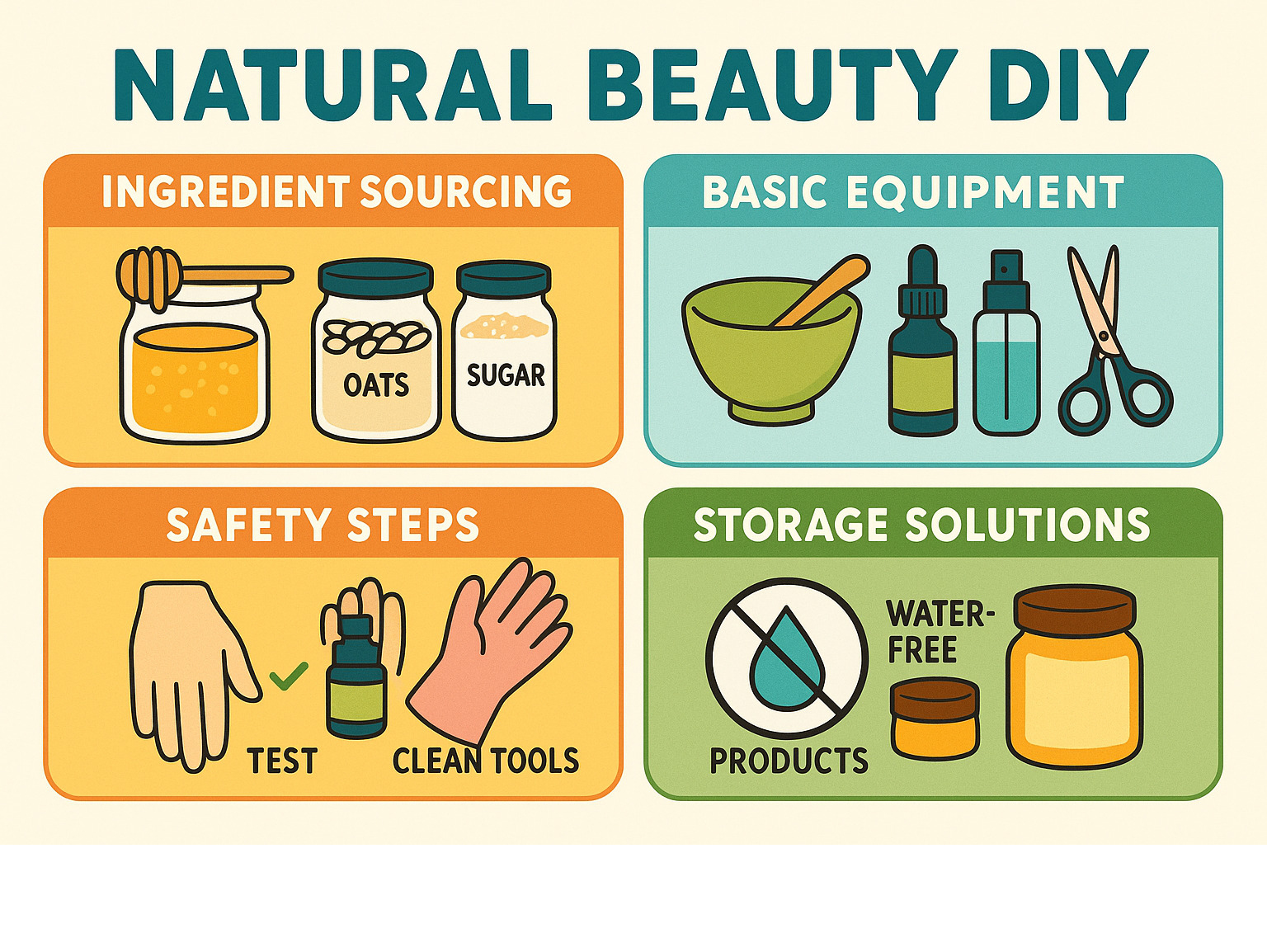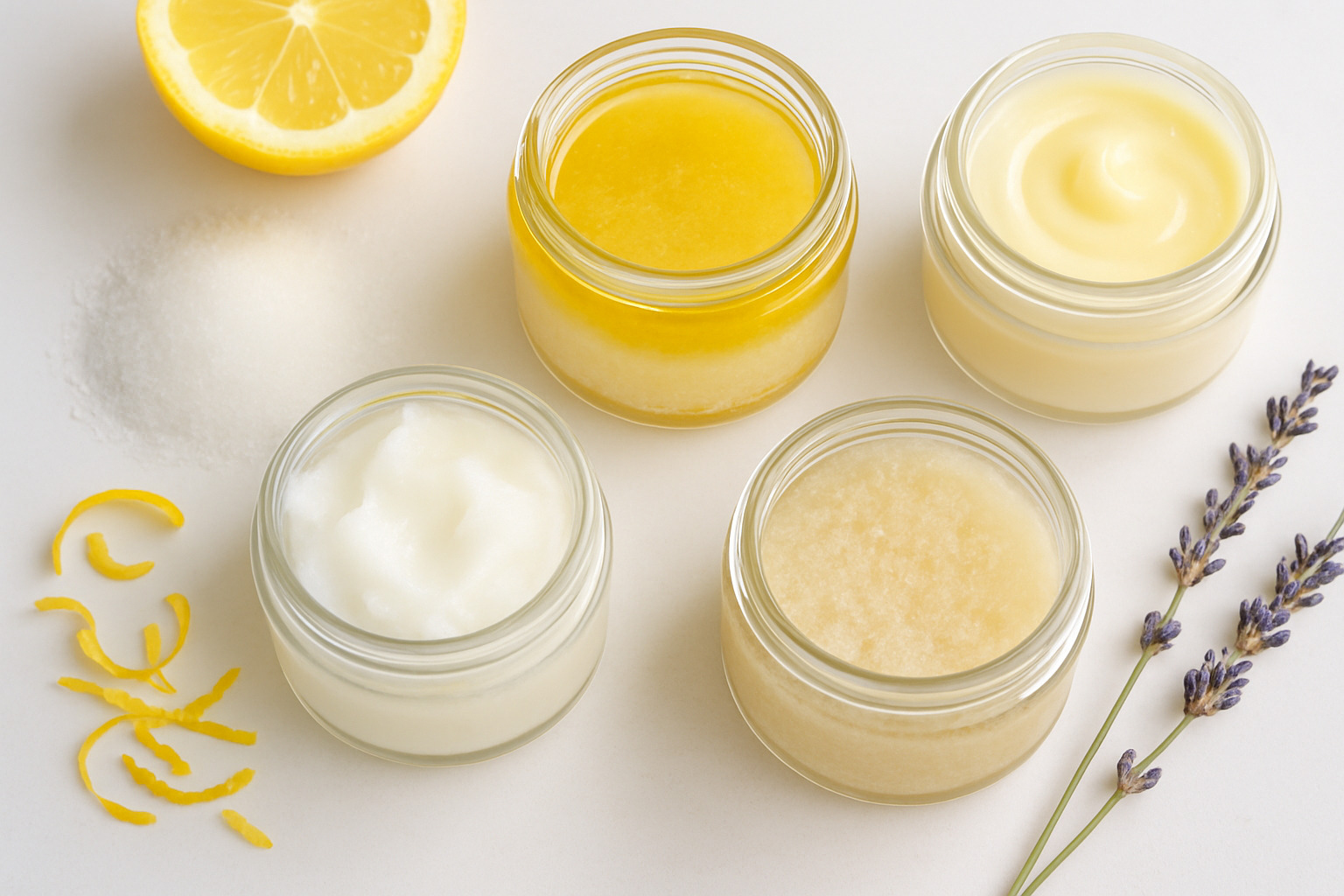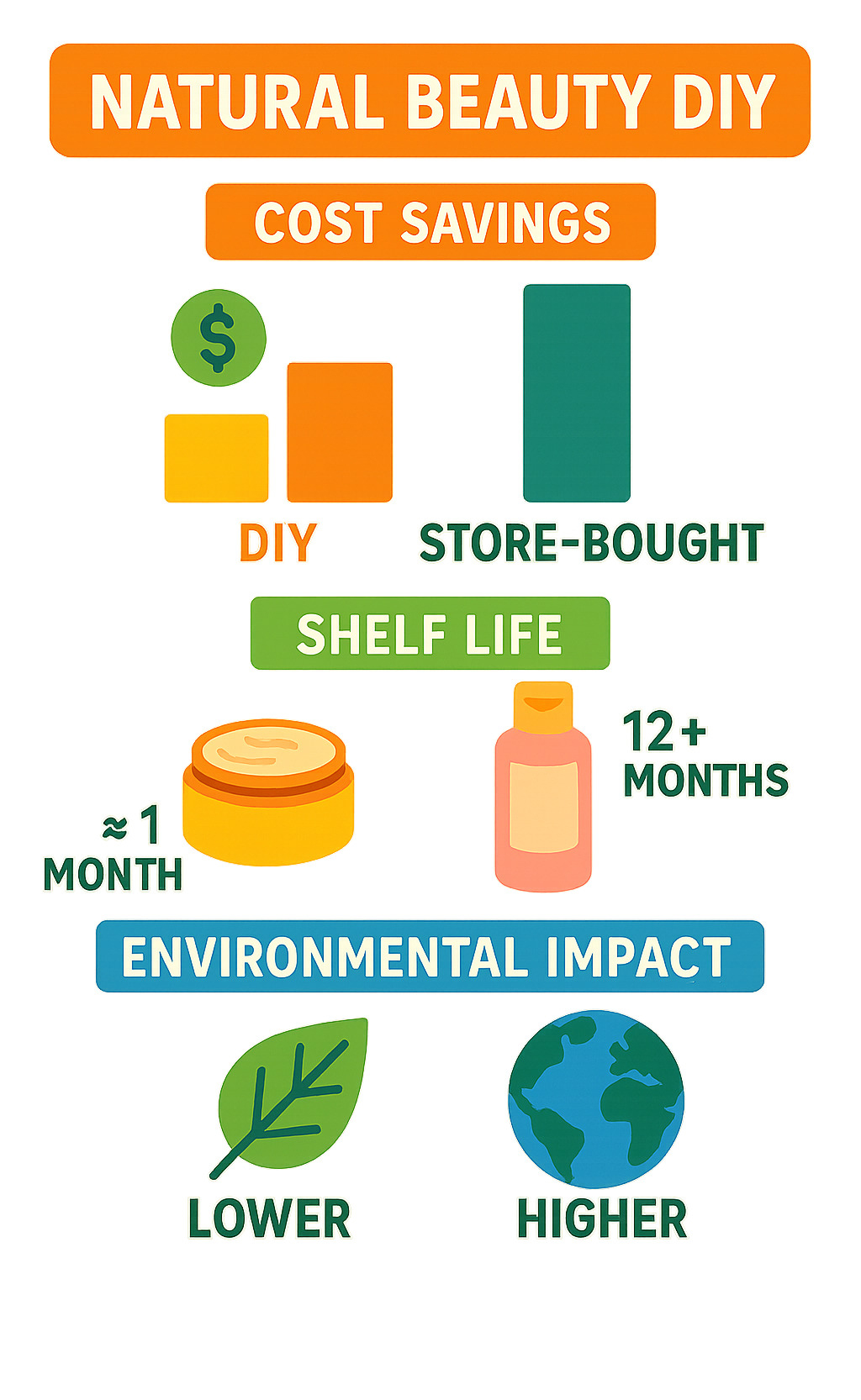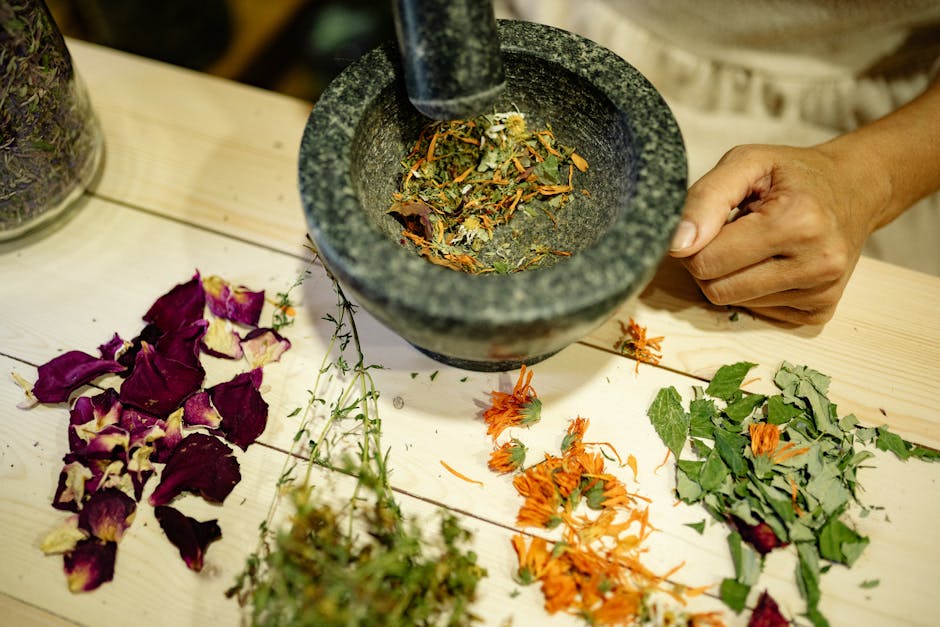Why Natural Beauty DIY is Taking Over Your Feed (And Your Bathroom)
Natural beauty DIY has exploded from a niche hobby into a mainstream movement, with over 100,000 people joining Formula Botanica’s training programs to learn homemade skincare formulation. Whether you’re seeking ingredient transparency, cost savings, or a more sustainable beauty routine, DIY recipes offer a powerful way to take control of what goes on your skin.
Quick Natural Beauty DIY Starter Guide:
- Easiest beginner products: Body butters, lip balms, and sugar scrubs (no preservatives needed)
- Essential pantry ingredients: Coconut oil, honey, oats, sugar, and olive oil
- Average cost savings: Single batches of homemade deodorant last 3 months at fraction of store prices
- Safety first: Always patch test and use clean tools to prevent contamination
- Storage tip: Water-free products last longer and are safer for beginners
The beauty industry giants we know today started as kitchen-table experiments run by female entrepreneurs. Today’s “skinimalist” trend aligns perfectly with DIY culture – fewer products, better ingredients, and formulations you can actually pronounce.
The science backs up the enthusiasm too. Fresh, small-batch formulations often outperform mass-produced products because they haven’t lost potency sitting on shelves for months.

Natural beauty DIY word roundup:
Why DIY Beauty? Science-Backed Benefits & Hidden Savings
The natural beauty DIY revolution isn’t just about following trends – it’s backed by real science and genuine savings that’ll make your wallet happy too.
When you whip up a face mask in your kitchen, you’re creating something fresh that hasn’t been sitting in a warehouse for months. Small-batch freshness means your ingredients are at their peak potency, unlike commercial products that lose effectiveness over time.
Ingredient transparency becomes beautifully simple when you’re the formulator. No more squinting at microscopic labels trying to pronounce chemical names. When your moisturizer contains just coconut oil, shea butter, and lavender essential oil, you know exactly what’s touching your skin.
The numbers tell an impressive story. A single batch of homemade deodorant costs under two dollars to make and lasts three months – compare that to spending fifteen to twenty dollars on store-bought versions every few weeks.
Zero-waste wins happen naturally with DIY beauty. You’re reusing glass jars, buying ingredients in bulk, and eliminating countless plastic containers from your routine.
Here’s where natural beauty DIY really shines compared to commercial alternatives:
| Factor | DIY Natural Beauty | Store-Bought |
|---|---|---|
| Ingredient Control | Complete transparency | Often unclear or synthetic |
| Cost per Use | $0.50-2.00 | $5.00-50.00 |
| Freshness | Made fresh, used immediately | Months to years old |
| Customization | Fully adaptable | One-size-fits-all |
| Packaging Waste | Minimal, reusable containers | Single-use plastic |
| Preservatives | Optional for anhydrous products | Always required |
Self-customization power might be the biggest game-changer. Your oily T-zone doesn’t need the same treatment as your friend’s dry, sensitive skin. With DIY formulations, you can adjust ratios, swap ingredients, and create products that work specifically for your skin’s unique needs.
Budget-friendly formulations typically use just two to six ingredients – most already hiding in your kitchen pantry. This simplicity isn’t just economical; it’s often more effective than complex formulas loaded with unnecessary fillers.
10 Pantry Powerhouses Every Maker Needs
Your natural beauty DIY journey starts right in your kitchen. The most effective beauty treatments often come from simple pantry staples you probably already own.
Oats are your gentle giant for sensitive skin. Ground oats contain natural saponins that cleanse without stripping, plus beta-glucan that helps your skin hold onto moisture. They’re perfect for everything from daily cleansers to soothing masks.
Raw honey acts like nature’s multivitamin for your skin. This golden treasure is a natural humectant, meaning it pulls moisture from the air and locks it into your skin. The antibacterial properties make it excellent for acne-prone skin.
Coconut oil deserves its cult following in the DIY world. Unlike many oils that just sit on your skin’s surface, coconut oil’s lauric acid actually penetrates deeply. It’s anti-inflammatory, antibacterial, and works beautifully in everything from lip balms to hair masks.
Avocado brings serious nutrition to your beauty routine. Packed with vitamins A, D, and E, plus healthy fats that instantly plump and nourish skin, mashed avocado creates luxurious face masks that rival expensive spa treatments.
Sugar might seem basic, but it’s the perfect physical exfoliant. Brown sugar is gentler for facial scrubs, while white sugar tackles rough elbows and heels. Unlike harsh scrubs with jagged particles, sugar dissolves as you use it.
Olive oil brings Mediterranean beauty secrets to your bathroom. Extra virgin olive oil is loaded with antioxidants that help prevent premature aging. It’s especially wonderful for dry skin and makes an excellent makeup remover.
Plain Greek yogurt is like a mini chemical peel in your fridge. The lactic acid gently dissolves dead skin cells, while probiotics may benefit your skin’s natural barrier.
Aloe vera gel is your skin’s best friend after any irritation. Whether you’ve overdone it in the sun or tried a new product that didn’t agree with you, pure aloe vera soothes and heals.
Essential oils add both fragrance and therapeutic benefits to your creations. Lavender calms irritated skin, tea tree fights breakouts, and peppermint energizes tired feet. Always research proper dilution rates.
Baking soda rounds out your toolkit as a gentle pH balancer and mild exfoliant. It’s fantastic in DIY deodorants and can brighten teeth, though use it sparingly on facial skin.
For detailed safety information and sourcing tips, check out our comprehensive DIY skincare ingredients guide.
Focus Keyphrase Snapshot: Natural Beauty DIY Pantry Kit
Building your natural beauty DIY pantry kit around these multi-use staples gives you incredible bang for your buck. With just these ten ingredients, you can create over 50 different beauty products – from cleansers and moisturizers to hair treatments and body scrubs.
A $50 investment in quality pantry staples can replace hundreds of dollars worth of commercial beauty products. Plus, you’ll know exactly what’s going on your skin, and you can customize everything to work perfectly for you.
Natural Beauty DIY Starter Projects: Quick Wins for Face, Lips & Body
Let’s get your hands dirty! These beginner-friendly projects are perfect for dipping your toes into the natural beauty DIY world. I’ve carefully chosen recipes that don’t require fancy equipment or hard-to-find ingredients.
We’re starting with anhydrous formulations (water-free). These products don’t need preservatives, making them much safer and more forgiving for beginners. Think body butters, oil-based scrubs, and balms – they’re naturally stable and nearly impossible to mess up.
For detailed guides, check out our DIY face masks, DIY exfoliating scrubs for sensitive skin, and DIY sugar lip scrub with coconut oil. For additional inspiration, see these homemade face scrubs for every skin type.
3-Step Oatmeal Glow Mask (Natural Beauty DIY Classic)
This is the natural beauty DIY recipe that converts skeptics into believers. It’s gentle enough for sensitive skin but effective enough to give you that coveted post-facial glow.
Oats naturally cleanse and exfoliate without being harsh, honey acts like a moisture magnet while fighting bacteria, and Greek yogurt provides gentle lactic acid for natural radiance.
What you’ll need:
- 2 tablespoons ground oats (pulse regular oats in your blender)
- 1 tablespoon raw honey
- 1 tablespoon plain Greek yogurt
The simple process: Mix everything in a clean bowl until you get a spreadable paste. Apply to clean skin (skip the eye area), relax for 15-20 minutes, then rinse with warm water.
For the complete technique, check out this easy three-step oatmeal facial mask guide.
Pantry-Sugar Body Polish
Transform your everyday shower into a spa experience with this energizing scrub that brightens and smooths while filling your bathroom with amazing citrusy scent.
Brown or white sugar sloughs away dead skin cells, olive oil provides deep moisturization, and fresh lemon zest delivers natural brightening thanks to its citric acid content.
Gather these ingredients:
- 1 cup brown or white sugar
- 1/3 cup olive oil
- Zest of 1 fresh lemon
- 5-10 drops lemon essential oil (optional)
Creating your polish: Combine sugar and lemon zest in a clean jar, then slowly drizzle in olive oil until you reach perfect consistency. Store in a shower-safe jar with tight lid.
Whipped Coconut-Lavender Moisturizer
This luxurious, butter-soft moisturizer melts into your skin like a dream and provides long-lasting hydration without greasy residue.
The whipping process incorporates air to create incredibly light, easily absorbed texture. Coconut oil provides deep nourishment, vitamin E acts as natural preservative, and lavender essential oil adds spa-like aromatherapy.
Your ingredient list:
- 1/2 cup coconut oil (solid at room temperature)
- 1 teaspoon vitamin E oil
- 10-15 drops lavender essential oil
The whipping magic: With coconut oil at room temperature but still solid, use a hand mixer to whip for 2-3 minutes until light and fluffy. Add vitamin E and lavender oils, whip another minute until combined. Transfer to clean jars.

Customizing & Troubleshooting Your Formulas
One of the biggest advantages of natural beauty DIY is customizing formulations for your specific needs. This means understanding how ingredients interact and fixing common problems.
Understanding Your Skin’s Needs:
- Oily/Acne-Prone: Focus on clay-based masks, lighter oils like jojoba, and antibacterial ingredients like tea tree oil
- Dry/Mature: Emphasize heavier oils like avocado or argan, plus humectants like honey and glycerin
- Sensitive: Stick to gentle ingredients like oats, chamomile, and avoid citrus essential oils
- Combination: Create targeted treatments for different areas of your face
Essential Oil Safety Guidelines:
Never exceed dermal safety limits for essential oils. Most should be diluted to 0.5-2% in skincare products. When in doubt, less is more.
Common Troubleshooting Issues:
Separation Problems: If your oil-based products separate, try ensuring all ingredients are at similar temperatures when mixing, adding small amounts of beeswax as natural emulsifier, or storing products in cooler locations.
Texture Issues: Too thick? Add more liquid oil. Too thin? Add more solid ingredients like shea butter or beeswax.
For comprehensive guidance, visit our DIY natural skincare resource.
Natural Beauty DIY for Oily vs Dry Skin
For Oily Skin:
- Base ingredients: Clay (bentonite or kaolin), witch hazel, jojoba oil
- Beneficial additions: Tea tree oil, lemon (rinse-off products only), charcoal
- Avoid: Heavy oils like coconut or olive oil on the face
For Dry Skin:
- Base ingredients: Shea butter, avocado oil, honey, oats
- Beneficial additions: Vitamin E, rosehip oil, chamomile
- Avoid: Clay masks, alcohol-based toners, over-exfoliation
Ingredient Red-Flags to Avoid
Phototoxic Citrus Oils: Bergamot, lime, lemon, and grapefruit essential oils can cause severe burns when exposed to sunlight. Never use in leave-on products.
Undiluted Cinnamon Essential Oil: Can cause severe skin irritation. If using cinnamon, opt for ground spice in rinse-off products only.
Water-Based Products Without Preservatives: Any formulation containing water will grow harmful bacteria within days without proper preservation.
Storage, Shelf Life & Lab-Level Hygiene
Think of your kitchen as a mini cosmetics lab when creating natural beauty DIY products. The same care you’d take preparing food should guide your beauty-making process.
Creating a clean workspace starts before you touch your first ingredient. Wipe down surfaces with rubbing alcohol, wash hands thoroughly, and gather clean utensils. Consider wearing gloves if making multiple batches.
Sterilizing your tools and containers is your first line of defense against bacteria. A quick wipe with rubbing alcohol works for glass jars, mixing bowls, and spoons. Always use distilled water when recipes call for water.
Amber glass jars protect light-sensitive ingredients like vitamin E and essential oils from breaking down. Airtight containers prevent oxidation and keep bacteria out. Mason jars work beautifully for body scrubs, while small tins are perfect for lip balms.
Your refrigerator becomes an extension of your beauty cabinet. Water-based formulations without preservatives need refrigeration and should be used within 1-2 weeks maximum. Fresh ingredient masks should be used immediately or stored for no more than three days in the fridge.
Batch dating everything is crucial. Use permanent markers or labels to note when you made each product and when it should be tossed.
Anhydrous products (without water) like body butters and sugar scrubs typically stay fresh for 6-12 months when stored properly. Oil-based products generally last 6-8 months before you might notice rancid smells.
Patch testing isn’t optional. Apply small amounts of new formulations to your inner wrist, cover with bandage, and wait 24-48 hours. Even natural ingredients can cause reactions.
Watch for warning signs that products have gone bad. Changes in smell, color, or texture are red flags. When in doubt, throw it out.
For comprehensive safety guidelines, explore our DIY beauty treatments guide.
Natural beauty DIY products are living formulations without harsh synthetic preservatives. They require more attention than store-bought products, but the payoff in freshness and effectiveness makes the extra care worthwhile.
Eco-Friendly Packaging, Gifting & Side-Hustle Tips
Your natural beauty DIY journey doesn’t have to end with the last drop of homemade moisturizer. The sustainability mindset naturally extends to how we package, share, and potentially sell our creations.
Sustainable packaging becomes part of the fun when you think creatively. Empty jam jars are perfect for body scrubs and masks. Recyclable metal tins work beautifully for solid balms and deodorants, giving products a professional look without environmental guilt.
Kraft paper labels let you customize each jar with handwritten ingredient lists. Add some twine or dried lavender, and your kitchen creation looks like it came from an expensive boutique.

Gift-giving with homemade beauty products creates meaningful connections. Create themed sets – a “Winter Comfort” collection with warming essential oils, or “Summer Glow” package featuring brightening citrus scrubs.
Include handwritten instruction cards with each gift. People love knowing exactly what’s in their products and how to use them safely.
Many successful beauty brands started exactly where you are now. Formula Botanica’s research shows that artisan beauty brands often begin with a single homemade product that friends and family can’t stop raving about.
The numbers are encouraging for anyone considering a side hustle. A single batch of body butter costs about $3-5 to make but can retail for $15-25. That’s healthy profit margins even for small-scale production.
Starting small makes sense. Focus on one or two signature products that you’ve perfected and that people consistently request.
Farmers markets and online platforms provide perfect testing grounds. You’ll get real feedback and learn what resonates beyond your immediate circle.
Remember to research local regulations for cosmetic sales before you start selling. Most areas have specific requirements for labeling and ingredient disclosure.
The beauty industry’s shift toward sustainability creates real opportunities for small producers who prioritize natural ingredients and eco-friendly practices.
Frequently Asked Questions about Natural Beauty DIY
How long do homemade products really last?
Anhydrous products – those made without water like body butters, lip balms, and oil-based scrubs – typically last 6-12 months when stored properly in cool, dark places using airtight containers.
Water changes everything. Once you add water to a formulation, you’re creating an environment where bacteria love to grow. Without preservatives, water-based products need refrigeration and should be used within 1-2 weeks maximum.
Fresh ingredient masks with things like avocado or yogurt should be used immediately and stored in the fridge for no more than 3 days. Warning signs include changes in smell, color, texture, or sudden skin irritation.
Can DIY recipes be as effective as store-bought?
Yes! When you make a fresh batch of face mask, those active ingredients are at peak potency. Compare that to store-bought products that might have been sitting on shelves for months, slowly losing effectiveness.
The customization factor is huge. Commercial products are formulated for the masses, but you can adjust ingredient ratios, swap out irritating components, and create formulations targeting your specific concerns.
You control the quality and concentration of every ingredient. While budget commercial products often use cheaper alternatives, you can choose the best materials your budget allows without paying for fancy packaging or marketing costs.
What basic equipment do I need to start?
You probably already have most of what you need in your kitchen. Your essential toolkit includes clean mixing bowls (glass or stainless steel), measuring cups and spoons, hand mixer or whisk, storage jars and containers, and labels for dating.
Helpful additions include a digital kitchen scale for precise measurements, amber glass bottles for light-sensitive formulations, small funnels for transferring liquids, and pH strips for water-based products.
Start simple with basic kitchen tools and gradually invest in specialized equipment as your interest grows.

Conclusion
The natural beauty DIY movement represents more than just a trend – it’s a return to intentional, mindful self-care that puts you in control of what goes on your skin. You’ve finded how simple pantry ingredients like oats, honey, and coconut oil can transform into luxurious skincare treatments that rival expensive commercial products.
You now have the knowledge to create fresh oatmeal masks that glow up your complexion, sugar scrubs that leave your skin silky smooth, and whipped moisturizers that melt into your skin like butter. These aren’t just beauty treatments – they’re acts of self-love that honor both your skin and your values.
At Beyond Beauty Lab, we believe that true beauty comes from understanding and nurturing your skin with pure, beneficial ingredients. The recipes and techniques we’ve shared here are just the beginning of your journey toward more conscious beauty practices.
Every expert was once a beginner. Start with simple formulations like sugar scrubs and lip balms, then gradually expand your skills as you gain confidence.
Your skin will thank you for the fresh, potent ingredients that haven’t been sitting on shelves for months. Your wallet will appreciate the dramatic savings. The planet benefits from reduced packaging waste and fewer harsh chemicals.
Natural beauty DIY is one of the most rewarding hobbies you can adopt. You’re not just mixing ingredients; you’re crafting a more sustainable, transparent, and effective beauty routine that reflects who you are.
Explore our comprehensive DIY natural beauty tips for advanced techniques and troubleshooting guidance. Take the next step toward your radiant, natural beauty DIY journey today – your future self will glow with gratitude.







